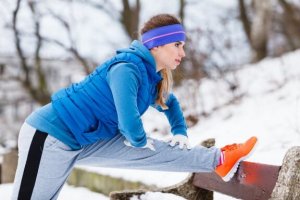Staying Healthy during the Winter

We often only associate diet and exercise with the summer, but we can still take care of ourselves in the winter too. In our post today, we have some healthy tips for keeping your weight steady and sickness at bay.
The best winter health tips
When the weather starts getting colder, we often think that staying at home and keeping trips outside to a minimum is the best way to stay healthy. But it couldn’t be further from the truth!
Thinking that we have to eat big, high-calorie meals is also misguided. In our post today, we have real health tips to face winter with your best foot forward:
1. Constantly hydrate yourself during winter
While you might not want to drink water when it’s cold, liquids are essential all-year-round.
You don’t need to drink three liters of water a day; but aim for the recommended two liters. If you’re feeling reluctant, try natural sugar-free herb teas instead.
2. Recommended fruits and vegetables for winter months
If you think that summer is the only season for fruits and vegetables, you’re wrong! You can enjoy delicious salads during winter as well–even fresh juices! By continuing with your fruit and vegetable intake, your body will have the nutrients it needs to combat sickness.
To give you an idea, you could have freshly-squeezed orange juice every day or a colorful salad along with your white or red meats. Or, you could always enjoy a nice soup of homemade vegetable soup to warm up your body.

3. Hygiene and ventilation
When it’s cold, we usually shrink away from showers–even hot ones. But maintaining good hygiene habits is the best way to fight against viral and bacterial illnesses that commonly accompany winter.
You should also open your windows at noon, or when the sun’s out, to ventilate your home. Opening your windows will keep your home from becoming a germ hot-spot. If you can, try having the windows open when you sleep as well.
Don’t forget to wash your hands well, too–especially if you’ve used public transport, handled cash or work in a closed area for long hours. On a further note, avoid contagious winter sicknesses by not touching your mouth, nose or eyes with dirty hands.
4. Exercise
Another healthy tip for this winter is getting exercise. You don’t have to go out for a run at 7:00 in the morning or 10:00 at night. But you should get your body moving. Now would be a good time to sign up at a gym or exercise outdoors when the sun’s out.
Not feeling any of these options? No problem, look for exercise clips online and workout at home. You won’t have to leave home if it’s windy, rainy or snowy. But stay on track and finish your workout!
5. Dress in layers
Whether you’re off to work, classes, grocery shop– you should bundle up. But remember that temperatures vary with the time of day and depending on what you’re doing, might warm up naturally.
Always dress in layers. Put on layers so that when you enter a heated space or step out into the cold, you won’t have to worry about sweating or freezing.
Avoiding sudden temperature changes is another thing to keep in mind. Bundle up before you go out and remove your jacket before coming back in. If you have the option of setting your home temperature, set it to around 71-75 degrees F.

6. Winter sun and skincare
Our last two winter tips are all about the skin. Even when it’s cold, the skin needs special care. Aside from staying hydrated, we recommend using a moisturizing lotion every morning; we especially recommend it if you live in a windy area that dries out your skin.
As for the sun, you might think that sun dangers only lurk in the summertime but that’s not true. Use sunglasses and protection when you’re out and about. Even when you go somewhere snowy! The sun’s reflection on the snow can give you an even greater burn than it would at the beach.
If you follow our tips, winter doesn’t have to mean sick days, boredom and grumpy moods. You’ll have a great season and enjoy this wonderful time of year!
We often only associate diet and exercise with the summer, but we can still take care of ourselves in the winter too. In our post today, we have some healthy tips for keeping your weight steady and sickness at bay.
The best winter health tips
When the weather starts getting colder, we often think that staying at home and keeping trips outside to a minimum is the best way to stay healthy. But it couldn’t be further from the truth!
Thinking that we have to eat big, high-calorie meals is also misguided. In our post today, we have real health tips to face winter with your best foot forward:
1. Constantly hydrate yourself during winter
While you might not want to drink water when it’s cold, liquids are essential all-year-round.
You don’t need to drink three liters of water a day; but aim for the recommended two liters. If you’re feeling reluctant, try natural sugar-free herb teas instead.
2. Recommended fruits and vegetables for winter months
If you think that summer is the only season for fruits and vegetables, you’re wrong! You can enjoy delicious salads during winter as well–even fresh juices! By continuing with your fruit and vegetable intake, your body will have the nutrients it needs to combat sickness.
To give you an idea, you could have freshly-squeezed orange juice every day or a colorful salad along with your white or red meats. Or, you could always enjoy a nice soup of homemade vegetable soup to warm up your body.

3. Hygiene and ventilation
When it’s cold, we usually shrink away from showers–even hot ones. But maintaining good hygiene habits is the best way to fight against viral and bacterial illnesses that commonly accompany winter.
You should also open your windows at noon, or when the sun’s out, to ventilate your home. Opening your windows will keep your home from becoming a germ hot-spot. If you can, try having the windows open when you sleep as well.
Don’t forget to wash your hands well, too–especially if you’ve used public transport, handled cash or work in a closed area for long hours. On a further note, avoid contagious winter sicknesses by not touching your mouth, nose or eyes with dirty hands.
4. Exercise
Another healthy tip for this winter is getting exercise. You don’t have to go out for a run at 7:00 in the morning or 10:00 at night. But you should get your body moving. Now would be a good time to sign up at a gym or exercise outdoors when the sun’s out.
Not feeling any of these options? No problem, look for exercise clips online and workout at home. You won’t have to leave home if it’s windy, rainy or snowy. But stay on track and finish your workout!
5. Dress in layers
Whether you’re off to work, classes, grocery shop– you should bundle up. But remember that temperatures vary with the time of day and depending on what you’re doing, might warm up naturally.
Always dress in layers. Put on layers so that when you enter a heated space or step out into the cold, you won’t have to worry about sweating or freezing.
Avoiding sudden temperature changes is another thing to keep in mind. Bundle up before you go out and remove your jacket before coming back in. If you have the option of setting your home temperature, set it to around 71-75 degrees F.

6. Winter sun and skincare
Our last two winter tips are all about the skin. Even when it’s cold, the skin needs special care. Aside from staying hydrated, we recommend using a moisturizing lotion every morning; we especially recommend it if you live in a windy area that dries out your skin.
As for the sun, you might think that sun dangers only lurk in the summertime but that’s not true. Use sunglasses and protection when you’re out and about. Even when you go somewhere snowy! The sun’s reflection on the snow can give you an even greater burn than it would at the beach.
If you follow our tips, winter doesn’t have to mean sick days, boredom and grumpy moods. You’ll have a great season and enjoy this wonderful time of year!
All cited sources were thoroughly reviewed by our team to ensure their quality, reliability, currency, and validity. The bibliography of this article was considered reliable and of academic or scientific accuracy.
- Comité de Salud y Medio Ambiente Soc Europ Enf respiratorias. (2015). La contaminación del aire exterior y los pulmones. European Lung Foundation Health & Environment Alliance.Recuperado de: https://www.europeanlung.org/assets/files/es/publications/aire_exterior_y_los_pulmones.pdf
- Secretaría de Salud. (2015). Guía de referencia rápida: Prevención, Diagnóstico y Tratamiento de la Influenza A (H1N1). In Guía de Referencia Rápida (pp. 1–22).
- Mateos, S. (2006). Virus respiratorios. In Temas de Bacteriología y virología Médica (2nd ed., pp. 429–447). Universidad de la Republica Facultad de Medicina. Retrieved from www.higiene.edu.uy/cefa/2008/Virusrespiratorios.pdf
- Fundación Femeba. Gripe y enfermedades respiratorias en el invierno. Información para la comunidad. Ministerio de Salud de la Nación Argentina. Recuperado de: http://www.fundacionfemeba.org.ar/sites/default/files/Gripe%20y%20enfermedades%20respiratorias%20en%20el%20invierno.pdf
This text is provided for informational purposes only and does not replace consultation with a professional. If in doubt, consult your specialist.








